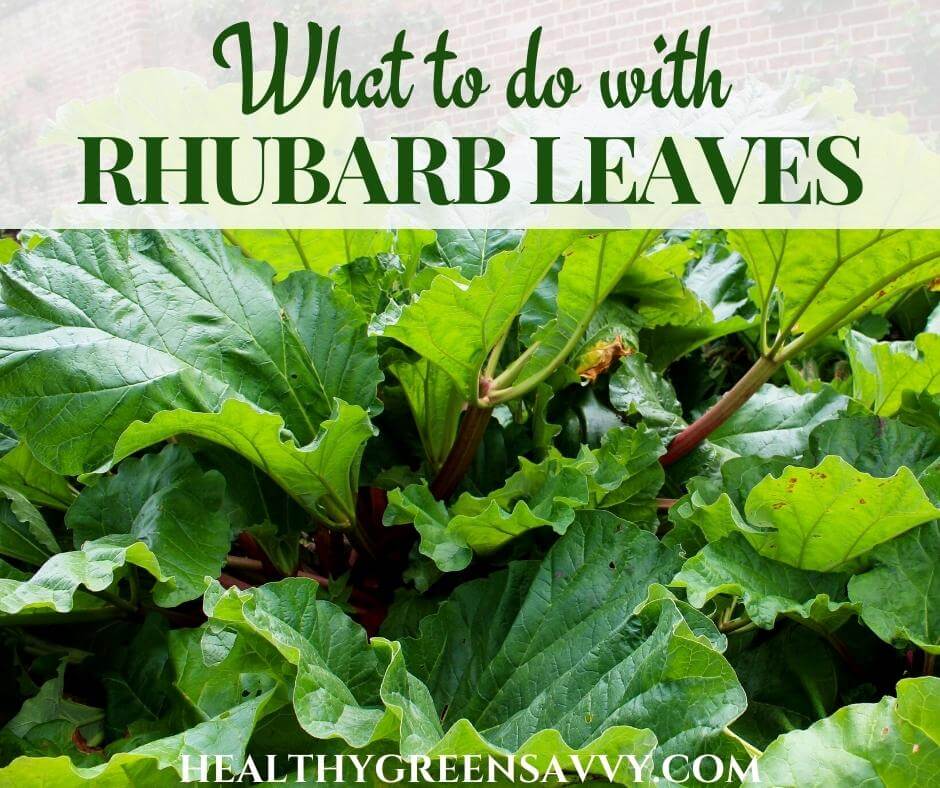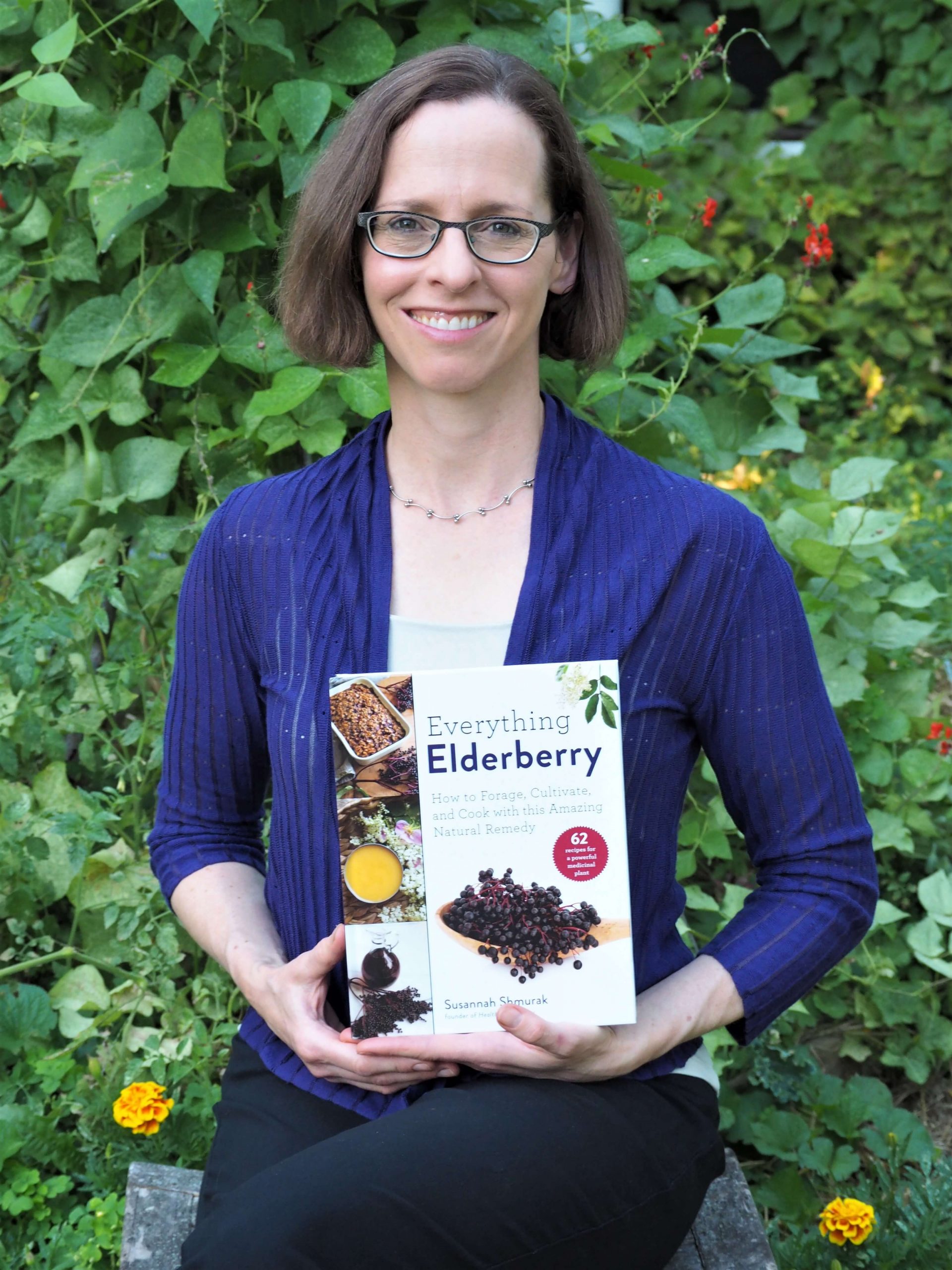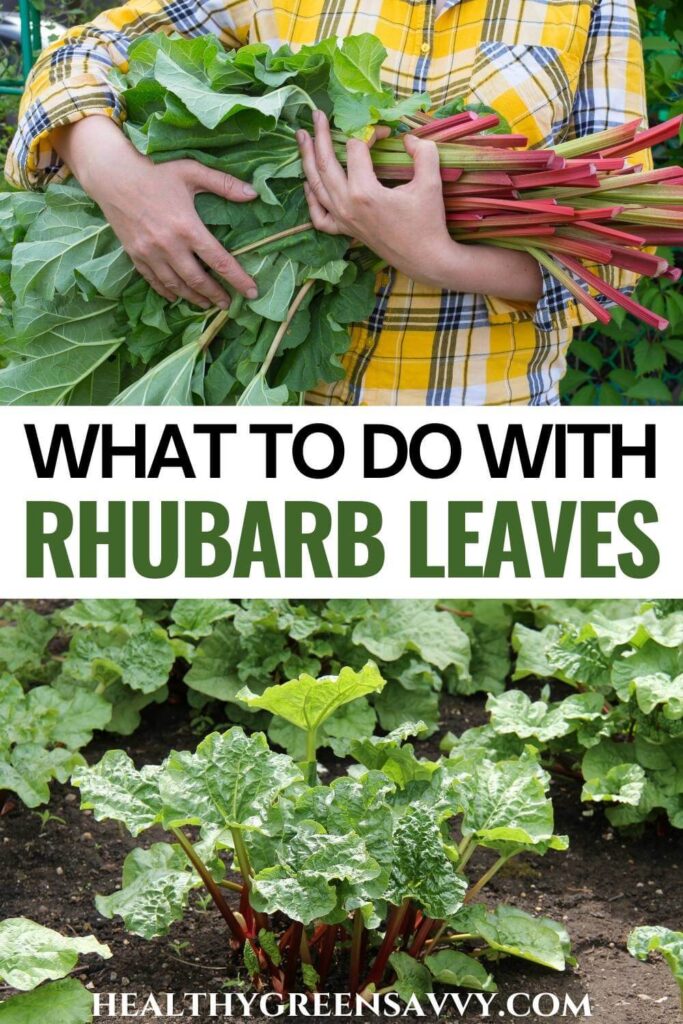Last Updated on June 14, 2024
Ever come in with a big bundle of spring rhubarb and wished you could eat some of those abundant leaves? If you’ve wondered whether rhubarb leaves are poisonous, here’s what you need to know about uses for rhubarb leaves that won’t make you sick (since eating them probably will). If you’re less familiar with rhubarb and have been told the whole plant is poisonous, we’ll clarify that as well.

WHAT PART OF RHUBARB IS POISONOUS?
First things first, let’s lay to rest the rumor that rhubarb stalks are poisonous. Rhubarb stalks are totally safe to eat, though they are on the tart side. If you consumed pounds and pounds of rhubarb, you might not feel great or stress your kidneys, but no one eats enough rhubarb at a sitting to make this a concern.
It’s rhubarb leaves that can be poisonous if eaten in great enough quantities. More on this issue below.
Rhubarb root is used in Chinese medicine, but don’t go eating rhubarb root or you’ll likely regret it. Only take prepared rhubarb root under the supervision of a trained TCM practitioner.
HOW POISONOUS ARE RHUBARB LEAVES?

We’re all about avoiding food waste, so eating parts of produce that are often discarded is common practice around here. We make banana peel tea, roast squash seeds, and turn carrot tops into pesto. You can check out these 40 root to stem recipes if you want to be inspired to do the same.
But in the case of rhubarb, we have to make our peace with not using the whole plant, as the leaves of rhubarb plants aren’t really good for us, though there’s some controversy about exactly why.
During food shortages in World War I, the British government suggested citizens eat rhubarb leaves, resulting in several cases of poisoning. One often-cited fatality caused by ingesting rhubarb leaves in 1917 cemented their reputation as highly toxic.
What happens if you eat rhubarb leaves? The oxalic acid in the leaves binds to calcium and removes it from the bloodstream, which can be lethal at a high enough dose. Calcium oxalate can also lead to kidney stones and kidney damage.
You’d need to eat many pounds of rhubarb leaves to get a fatal dose of oxalic acid, though smaller amounts can still make you feel pretty bad.
Plenty of other plants we consume contain even higher amounts of oxalates. You’ll find oxalic acid in spinach, purslane, and wood sorrel as well as in common foods like chocolate and tea.
Researchers therefore speculate that it’s not the oxalates but another compound in rhubarb, possibly anthraquinone glycoside, that may be behind rhubarb leaves’ toxicity.
So all that is to say, best not to eat leaves from your rhubarb plant, but also don’t freak out if a tiny amount of leaf winds up in your rhubarb sauce.
They’re also fine to touch. The ill effects of rhubarb leaves come from ingesting, not touching them.
Now, if you’re also growing lavender, you should know that both the buds and leaves are edible. Here are 11 ways to use lavender leaves in cooking, body care, and more.
USES FOR RHUBARB LEAVES
While rhubarb leaves aren’t edible, there are several ways you can use them for non-food purposes.
We hate waste around here, but since you’re not going to cook up the leaves left after you’ve made a big batch of rhubarb fruit leather, let’s find some good uses for those enormous leaves rather than sending them to the landfill.
1. USE RHUBARB LEAVES TO SMOTHER WEEDS
Put those leaves to use by creating a weed barrier out of them. The large leaves can be spread around any area where you’d like to suppress weeds. Layer them to cover the soil completely.
They break down quickly, though, so you’ll need to add more throughout the season. As they decompose, they’ll add nutrients to the soil.
2. MAKE HOMEMADE PESTICIDE
Ever notice how little rhubarb is bothered by pests? Proponents of rhubarb leaf pesticide think the compounds that make rhubarb leaves inadvisable for us to eat also make them unappetizing to leaf-destroying insects. There isn’t a lot of research to back this up, but it can’t hurt to try. Some folks contend that it can act as a fertilizer spray as well.
To make a DIY insecticide for garden plants, tear up a few rhubarb leaves and place them in a large stockpot. Cover with water, put the lid on the pot, and bring to a boil. Turn off the heat and allow to steep for at least a half an hour.
Next, strain out the leaves and put in a spray bottle, diluting with one part water. Add a squirt of dish soap to help the spray adhere to plants.
Try spraying plants you’re trying to protect daily and see if it helps repel unwanted insects.
Best to confine your use of this spray to the leaves of plants you don’t want to eat. I’m going to see if it dissuades the ravenous Japanese beetles from gnawing on my grapevines this season.
Store unused spray in a clearly-marked bottle in the refrigerator. It should keep for a few days.

3. USE RHUBARB LEAVES TO CLEAN AND POLISH
The oxalic acid that makes it a bad idea to eat rhubarb leaves makes them an excellent cleaner and stain remover. Put away the commercial scrub and try a rhubarb leaf solution instead.
You can extract the oxalic acid from leaves by boiling them for a half hour and straining. The pan you cook them in should look clean and shiny.
You can use the strained liquid to clean surfaces that won’t be harmed by acid, like your stainless steel or porcelain sinks. The oxalic acid may help remove stains from bathtubs and toilets as well. Wear gloves to protect skin from the acid, and avoid using on acid-sensitive surfaces like marble.
Store in a clearly-marked bottle in the refrigerator for a few days if you’re not using all your solution immediately.
4. DIY FABRIC DYE
Rhubarb leaves yield a yellow-green color that can be used for home dyeing projects, while their acidity provides a built-in mordant, helping to fix the dye to the fiber.
To make a rhubarb leaf dye, simmer cut up leaves in water for about an hour. Use roughly half as much leaf by weight as the fiber you plan to dye (i.e., 1 pound leaf for 2 pounds of yarn). Longer simmering should yield a darker dye.
Allow to cool and strain the leaf matter out before dyeing your yarn or cloth. Find out more about using natural dyes and mordants in A Garden to Dye For by Chris McLaughlin.
Use rhubarb leaves to make dyes that won’t be consumed. In other words, skip it for food-based DIY dyes!
5. ADD TO COMPOST
As with other leaves from the garden, putting leaves of rhubarb plants in the compost adds organic matter and minerals to your homemade garden gold. The oxalates and other compounds from rhubarb leaves will not harm your compost or the plants you use it on.
Like other large leaves, rhubarb leaves should be torn up into smaller pieces to allow them to break down more readily.
6. MAKE LEAF CAST STEPPING STONES OR BIRD BATHS
You can use those enormous, pretty leaves to make attractive casts that can become stepping stones or bird baths in the garden. Here’s a video tutorial for making a rhubarb leaf cast for a bird bath.
Garden Therapy has a tutorial for making stepping stones from leaves.
What will you do with your rhubarb leaves this season?
FAQS
IS RAW RHUBARB POISONOUS?
Some people wonder whether raw rhubarb is poisonous; it’s not. You do not need to cook rhubarb before eating, though because rhubarb recipes generally involve a lot of sugar, most rhubarb winds up getting cooked.
If you have a sour tooth, crunching on a little raw rhubarb will hit the spot. With a sprinkle of sugar, a small bowl of raw rhubarb is actually quite refreshing.
IS RHUBARB POISONOUS IF IT FREEZES?
Another rumor about rhubarb involves chemical changes that happen when rhubarb freezes. If your rhubarb plant goes through a hard frost, the oxalates in the leaves may move to the stalks, making stalks much higher in oxalic acid than usual.
To avoid consuming too much oxalic acid, experts recommend we don’t eat rhubarb stalks that have been exposed to frost. According to several university extensions, damage to the leaves should be visible, and stalks will be mushy. Pull those and toss them in the compost. Stalks that grow after a frost should be unaffected.
Popping rhubarb stalks in the freezer without their leaves does not render them poisonous. Here’s more on freezing rhubarb if you find yourself with too much to eat at once.
ARE RHUBARB LEAVES POISONOUS TO DOGS AND OTHER ANIMALS?
For the same reasons rhubarb leaves can be toxic to humans, if dogs, cats, or horses consume them, they can also cause problems with kidney function. Call your vet if you think your pet has eaten the leaves of rhubarb plants.
Chickens may also be poisoned if they consume rhubarb leaves, though some chicken owners report no issues when their chickens nibble on them. Keep an eye on your chickens if they do consume rhubarb leaf, and call your vet if they appear ill.
USING YOUR NOT-POISONOUS RHUBARB STALKS
Once you’ve got a big harvest of rhubarb stalks, you’ll need loads of ways to use them. Here are more than 40 healthy rhubarb recipes to inspire you. If you need more after that, be sure to check out this fantastic rhubarb cookbook!
Our favorite ways to use our bountiful spring rhubarb is in rhubarb fruit leather or classic rhubarb crisp. Plenty becomes rhubarb sauce and rhubarb juice as well.
Rhubarb is a fantastic plant for the permaculture garden, a tough-as-nails perennial vegetable that provides copious amounts of (non-poisonous) rhubarb stalk to be added to all sorts of delicious spring treats. Here’s how to grow rhubarb if you’d like to enjoy some for yourself.
It turns out rhubarb flowers are edible as well if you want to try a more unusual way to enjoy your rhubarb.
If you love putting things that would normally head to the compost pile to use, be sure to check out these uses for used coffee grounds, as well as this important info on how to use coffee grounds in the garden. Here’s the skinny on banana peel fertilizer if you’ve heard the hype about that as well.
You can also try these 35 genius uses for orange peels.
Pin to save this info on uses for rhubarb leaves for later!

Photo credits: Ian Murdoch, daseaford, Marika Kosheleva

Susannah is a proud garden geek and energy nerd who loves healthy food and natural remedies. Her work has appeared in Mother Earth Living, Ensia, Northern Gardener, Sierra, and on numerous websites. Her first book, Everything Elderberry, released in September 2020 and has been a #1 new release in holistic medicine, naturopathy, herb gardening, and other categories. Find out more and grab your copy here.


 Hi, I'm Susannah, a garden geek, energy nerd, and fan of healthy food and natural remedies. Need some simple, practical solutions for living healthier and greener? You've come to the right place! More about me and my green projects
Hi, I'm Susannah, a garden geek, energy nerd, and fan of healthy food and natural remedies. Need some simple, practical solutions for living healthier and greener? You've come to the right place! More about me and my green projects